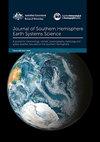Redefining southern Australia’s climatic regions and seasons
IF 3.6
4区 地球科学
Q1 Earth and Planetary Sciences
引用次数: 8
Abstract
Climate scientists routinely rely on averaging over time or space to simplify complex information and to concisely communicate findings. Currently, no consistent definitions of ‘warm’ or ‘cool’ seasons for southern Australia exist, making comparisons across studies difficult. Similarly, numerous climate studies in Australia use either arbitrarily defined areas or the Natural Resource Management (NRM) clusters to perform spatial averaging. While the NRM regions were informed by temperature and rainfall information, they remain somewhat arbitrary. Here we use weather type influence on rainfall and clustering methods to quantitatively define climatic regions and seasons over southern Australia. Three methods are explored: k-means clustering and two agglomerative clustering methods, Ward linkage and average linkage. K-means was found to be preferred in temporal clustering, while the average linkage method was preferred for spatial clustering. For southern Australia as a whole, we define the cool season as April–September and warm season as October–March, though we note that a three-season split may provide more nuanced climate analysis. We also show that different regions across southern Australia experience different seasons and demonstrate the changing spatial influence of weather types with the seasons, which may aid regionally or seasonally specific climate analysis. Division of southern Australia into 15 climatic regions shows localised agreement with the NRM clusters where distinct differences in rainfall amounts exist. However, the climate regions defined here better represent the importance of topographical aspect on weather type influence and the inland extent of particular weather types. We suggest that the use of these regions would provide consistent climate analysis across studies if widely adopted. A key requirement for climate scientists is the simplification of data sets into both seasonally or regionally averaged subsets. This simplification, by grouping like regions or seasons, is done for a number of reasons both scientific and practical, including to help understand patterns of variability, underlying drivers and trends in climate and weather, to communicate large amounts of data concisely, to reduce the amount of data required for processing (which becomes increasingly important with higher resolution climate model output), or to more simply draw a physical boundary between regions for other purposes, such as flora and fauna habitat analysis, appropriate agricultural practices or water management.重新定义南澳大利亚的气候区域和季节
气候科学家通常依靠时间或空间的平均来简化复杂的信息,并简明地传达发现。目前,澳大利亚南部没有“温暖”或“凉爽”季节的一致定义,这使得研究之间的比较变得困难。同样,澳大利亚的许多气候研究要么使用任意定义的区域,要么使用自然资源管理(NRM)集群来进行空间平均。虽然NRM区域是由温度和降雨信息通知的,但它们仍然有些武断。在这里,我们使用天气类型对降雨的影响和聚类方法来定量定义澳大利亚南部的气候区域和季节。探讨了三种聚类方法:k-均值聚类和Ward连锁和平均连锁两种聚类方法。结果表明,k -均值法在时间聚类中更优,而平均关联法在空间聚类中更优。对于整个南澳大利亚,我们将凉爽季节定义为4月至9月,温暖季节定义为10月至3月,尽管我们注意到三个季节的分裂可能提供更细致入微的气候分析。我们还表明,南澳大利亚不同地区经历不同的季节,并展示了天气类型随季节变化的空间影响,这可能有助于区域或季节特定的气候分析。将南澳大利亚划分为15个气候区显示了与降雨量存在明显差异的NRM集群的局部一致。然而,这里定义的气候区更好地代表了地形方面对天气类型影响的重要性以及特定天气类型的内陆范围。我们建议,如果广泛采用这些区域,将在研究中提供一致的气候分析。气候科学家的一个关键要求是将数据集简化为季节或区域平均子集。通过将区域或季节分组来进行这种简化,有许多科学和实际的原因,包括帮助理解气候和天气的变率模式、潜在驱动因素和趋势,简明地传达大量数据,减少处理所需的数据量(随着气候模式输出的分辨率越来越高,这一点变得越来越重要),或者为了其他目的更简单地在区域之间划出物理边界。例如动植物栖息地分析、适当的农业做法或水管理。
本文章由计算机程序翻译,如有差异,请以英文原文为准。
求助全文
约1分钟内获得全文
求助全文
来源期刊

Journal of Southern Hemisphere Earth Systems Science
Earth and Planetary Sciences-Oceanography
CiteScore
8.10
自引率
8.30%
发文量
0
审稿时长
>12 weeks
期刊介绍:
The Journal of Southern Hemisphere Earth Systems Science (JSHESS) publishes broad areas of research with a distinct emphasis on the Southern Hemisphere. The scope of the Journal encompasses the study of the mean state, variability and change of the atmosphere, oceans, and land surface, including the cryosphere, from hemispheric to regional scales.
general circulation of the atmosphere and oceans,
climate change and variability ,
climate impacts,
climate modelling ,
past change in the climate system including palaeoclimate variability,
atmospheric dynamics,
synoptic meteorology,
mesoscale meteorology and severe weather,
tropical meteorology,
observation systems,
remote sensing of atmospheric, oceanic and land surface processes,
weather, climate and ocean prediction,
atmospheric and oceanic composition and chemistry,
physical oceanography,
air‐sea interactions,
coastal zone processes,
hydrology,
cryosphere‐atmosphere interactions,
land surface‐atmosphere interactions,
space weather, including impacts and mitigation on technology,
ionospheric, magnetospheric, auroral and space physics,
data assimilation applied to the above subject areas .
Authors are encouraged to contact the Editor for specific advice on whether the subject matter of a proposed submission is appropriate for the Journal of Southern Hemisphere Earth Systems Science.
 求助内容:
求助内容: 应助结果提醒方式:
应助结果提醒方式:


